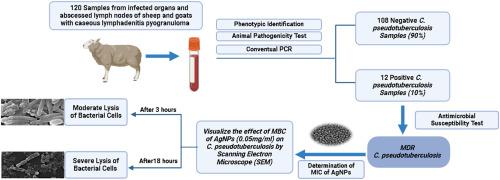Antibacterial activity of silver nanoparticles against MDR Corynebacterium pseudotuberculosis isolated from caseous lymphadenitis cases
IF 3.5
3区 医学
Q3 IMMUNOLOGY
引用次数: 0
Abstract
Corynebacterium pseudotuberculosis (C. pseudotuberculosis) is a zoonotic pathogen with a poor treatment outcome. It causes a number of chronic disorders, such as caseous lymphadenitis (CLA) in sheep and goats. Also, it can spread to humans and cause potential health events. 120 samples from infected organs and abscessed lymph nodes of sheep and goats with caseous lymphadenitis pyogranulomas were isolated. 10 % (12) of samples were positive for C. pseudotuberculosis by phenotypic methods, pathogenicity testing of guinea pigs, and PCR for the 16 S rRNA. Then they were characterized for their antibiotic susceptibility. We studied the effect of silver nanoparticles (Ag-NPs) on a pan-drug-resistant strain of C. pseudotuberculosis that showed resistance to six classes of antibiotics. In this study, the minimum inhibitory concentration (MIC) was 0.1 mg/ml (100 ppm) and the minimum bactericidal concentration (MBC) of Ag-NPs were 0.05 mg/ml (50 ppm). In this study, the effects of Ag-NPs on the C. pseudotuberculosis morphology, indicated by scanning electron microscopy (SEM) at Matrouh Governorate, revealed pronounced morphological changes indicating damage and rupture of the bacterial membrane. In conclusion, Ag-NPs could be a promising treatment for caseous lymphadenitis pyogranulomas.

纳米银对干酪性淋巴结炎耐多药假结核棒状杆菌的抑菌活性研究。
假结核棒状杆菌是一种治疗效果较差的人畜共患病原体。它引起许多慢性疾病,如绵羊和山羊的干酪样淋巴结炎(CLA)。此外,它可以传播给人类并引起潜在的健康事件。从绵羊和山羊的肉芽肿性干酪样淋巴结炎感染器官和脓肿淋巴结中分离120份样本。经表型法、豚鼠致病性检测和16S rRNA PCR检测,10%(12)样品假结核杆菌阳性。然后对它们的抗生素敏感性进行表征。我们研究了银纳米颗粒(Ag-NPs)对一种对六类抗生素耐药的伪结核杆菌的影响。在本研究中,Ag-NPs的最低抑菌浓度(MIC)为0.1 mg/ml (100 ppm),最低杀菌浓度(MBC)为0.05 mg/ml (50 ppm)。在这项研究中,Ag-NPs对假结核杆菌形态的影响,通过扫描电子显微镜(SEM)在Matrouh省显示出明显的形态变化,表明细菌膜的损伤和破裂。总之,Ag-NPs可能是一种有希望的治疗干酪性淋巴结炎化脓性肉芽肿的方法。
本文章由计算机程序翻译,如有差异,请以英文原文为准。
求助全文
约1分钟内获得全文
求助全文
来源期刊

Microbial pathogenesis
医学-免疫学
CiteScore
7.40
自引率
2.60%
发文量
472
审稿时长
56 days
期刊介绍:
Microbial Pathogenesis publishes original contributions and reviews about the molecular and cellular mechanisms of infectious diseases. It covers microbiology, host-pathogen interaction and immunology related to infectious agents, including bacteria, fungi, viruses and protozoa. It also accepts papers in the field of clinical microbiology, with the exception of case reports.
Research Areas Include:
-Pathogenesis
-Virulence factors
-Host susceptibility or resistance
-Immune mechanisms
-Identification, cloning and sequencing of relevant genes
-Genetic studies
-Viruses, prokaryotic organisms and protozoa
-Microbiota
-Systems biology related to infectious diseases
-Targets for vaccine design (pre-clinical studies)
 求助内容:
求助内容: 应助结果提醒方式:
应助结果提醒方式:


